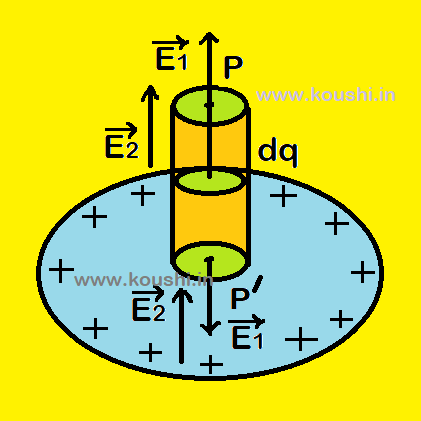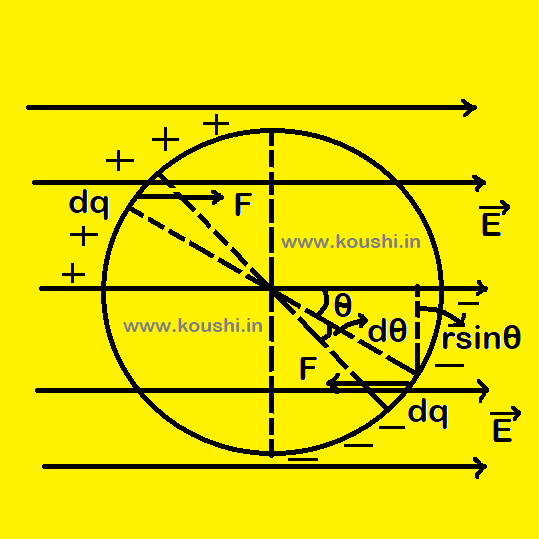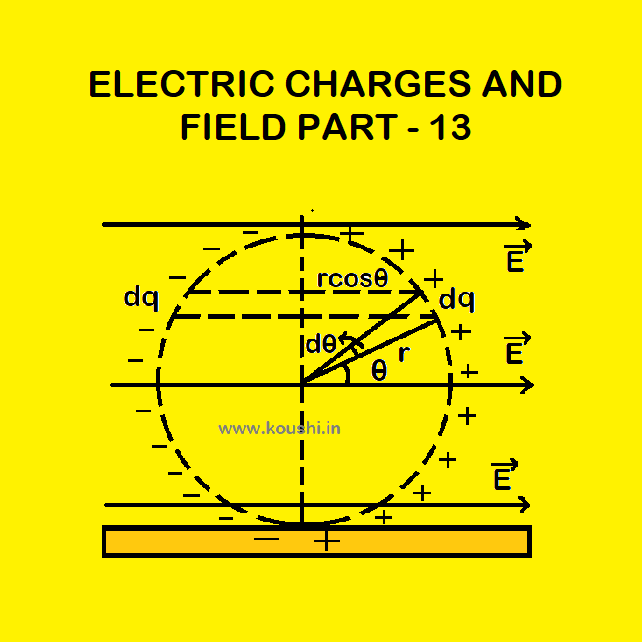Force per unit area of a charged conductor:
Let us consider the electric field E at any point P very near, but outside, the surface of a charged conductor is E = E1 + E2. Where E1 is the field due to the charge of small area ds around P, and E2 due to the charge on the rest of the surface.
Consider a point P’ opposite to P near the surface, but inside the conductor. For the point P’ the electric field E = E1 – E2 = 0.
So, E1 = E2 = ![]() . The electric field near the surface of a charged conductor is E =
. The electric field near the surface of a charged conductor is E = ![]() . Where
. Where ![]() is the surface charge density.
is the surface charge density.
The force acting on the charge ![]() ds due to the charges of rest of the surface is F =
ds due to the charges of rest of the surface is F = ![]() dsE2 =
dsE2 = ![]() .
.
Force per unit area of a charged conductor is ![]() =
= ![]() =
= ![]() .
.

Dipole moment on a charged ring:
A nonconducting ring of mass m radius r is vertically rest on a smooth non conducting horizontal plane. Charges +q and -q is distributed uniformly on the ring. Let dq is the charge at an angle ![]() for elementary part dl of the ring. So, dq = λrdθ. The dipole moment for dq on both side of the ring is dP = dq2r cos
for elementary part dl of the ring. So, dq = λrdθ. The dipole moment for dq on both side of the ring is dP = dq2r cos ![]() = λrdθ2r cos
= λrdθ2r cos ![]() = 2λr2 cos
= 2λr2 cos ![]() dθ.
dθ.
The net dipole moment for the entire ring is
P = ![]() = 2λr2
= 2λr2 ![]() cos
cos ![]() d
d ![]() = 2λr2[sin
= 2λr2[sin ![]()
![]() = 4λr2 =4r2(
= 4λr2 =4r2(![]() ) =
) = ![]() .
.

The torque acting on the ring in electric field:
A nonconducting ring of radius r is vertically rest on a smooth non conducting horizontal plane. Charges +q and -q is distributed uniformly on ![]() th part of the ring as shown in figure. A uniform electric field E is set up parallel to the horizontal plane. Let dq is the charge at an angle
th part of the ring as shown in figure. A uniform electric field E is set up parallel to the horizontal plane. Let dq is the charge at an angle ![]() for elementary part dl of the ring.
for elementary part dl of the ring.
So, dq = λrdθ. Force acting on dq is dF = dqE = λrdθE.
The torque due to E is d![]() = dF2r sin
= dF2r sin ![]() = 2λr2E sin
= 2λr2E sin ![]() dθ
dθ
The torque acting on the ring is ![]() =
= ![]() = 2λr2E
= 2λr2E ![]() sin
sin ![]() d
d ![]() = 2λr2E = 2Er2(
= 2λr2E = 2Er2( ![]() ) =
) = ![]() .
.

Click the button to go to the previous part of this chapter.
